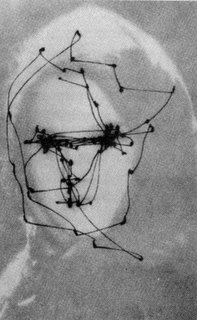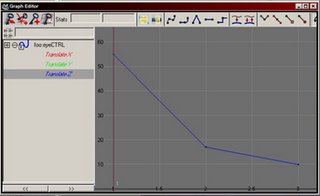
Here's an interesting link I've had around for a while. It details the nature of how our eyes move. Follow some of the other research links from that page if you're really interested in geeking out about this stuff.
Most of us know that one of the best ways to keep a character alive and thinking is subtle eye shifts. As with anything try not to over do it or else things can look a bit spastic and fake. But when done well and well placed there's a lot of power in using well timed shifting of the eyes. The shift could be motivated by the internal thoughts or feelings of the character while they are presented with a moment of quietness or thought. There the relative pace of the shfts gives indication to the speed of the unfolding of thoughts in the head or the emotional energy of the moment. If the darts are fast paced and come quickly one after the other it can indicate a great flurry of thought or a rapid firing of emotional energy. Slower pace indicates a more methodical, more pondering state of mind. This kind of eye darting is pretty common in animation these days.
Another motivator for eye darts (which I don't see as much of) could be the character's examining the face of another character they're talking to. We do this ALL the time. That's where the saccades come from, the constant exploration of our world around us to take the information in. It's a but harder to do because managing eyelines in animation is such a difficult thing to get right in the first place. Eyelines are so very fragile. If you're off just a little bit suddenly your character doesn't seem to be connected to their moment. So once you get a solid eyeline working sometimes we're a bit afraid to mess with it. But we don't just lock eyes with any one thing for very long. We'll examine, we'll move around, scanning, processing. When listening to another person we'll be drawn to their eyes first -individually- then to the mouth. We'll roll over this heirarchy for a bit as we piece together the other person's demeanor. That's how we read the intentions of those around us. Then our attention will turn to areas of high contrast. First in motion, second in brightness value, third in color. It's definitely hard to pull off well without ruining the eyeline of your character, but when you can get it working it adds so much life to the character as they listen or speak to another character.
I like to keep eye shifts quick. Usually 2 frames with a favor on the inbetween toward the end. A motion curve for a typical eye shift for me would have this kind of a pattern...
 And always remember that when the eyeball moves it affects the fleshy bits around the eyes. The lids mostly, but also beyond the immediate lids in a very limited and subtle way. if your rig doesn't move that sutf automatically it'll be up to you to get it working.
And always remember that when the eyeball moves it affects the fleshy bits around the eyes. The lids mostly, but also beyond the immediate lids in a very limited and subtle way. if your rig doesn't move that sutf automatically it'll be up to you to get it working.Anyhow... hope that is useful to some folks out there.
10 comments:
Sorry if this question seems a bit daft but aren't we talking about a three frame move in total here. I'm a little confused by the "Two frames with an ease toward the second frame" Wouldn't that be a key on .5 of a frame? The graph editor jpeg is a little small and I can't read the timeline. Awesome info Keith, if you could just clarify that for me I'd appreciate it.
Hey Anon,
Yeah, if you count the first key it's a 3 frame deal. Frame 1, start pose. Frame 2, ease to new pose. Frame 3, new eye position 100%. Sorry for the confusion. And Matt I think the trick is to keep it smaller rather than larger. Not too small or else it feels like a mistake, though.
If I may, Keith, I'd like to add some thoughts to your warning about being careful not to over do eye movements...
I think there might be a temptation to add lots of mini eye movements to bring extra life to a shot. I would encourage animators to watch actors (good actors, that is) very carefully. They train themselves to maintain solid eye contact during a conversation because it looks better on screen. Especially in older films, during a close up, watch how an actor focuses on just one of the other actor's eyes during a conversation (usually the one closer to the camera) so they won't be shifting between both eyes like we all tend to do naturally. Shifty eyes can create a distracting performance. Save your shifting for when you need it, like during a fearful or confusing emotion. When you save touches like this, they have a greater impact.
nice to see the new post
Awesome, thanks for sharing!!
Hey Keith. Thanks for posting this! I'm working on my final shot for the 3rd Quarter of Animation Mentor and was cleaning up my eye pass. This info couldn't have come at a better time. You rock!
JP
Just an add-on to the eye-tracking link:
it's interesting to note that the way a viewer's eyes take in an image is culturally influenced. Asian viewers, for example, spend much more time on background details while Western viewers (typical of the image you linked) concentrate almost exclusively on foreground objects.
I love these kinds of observations. Keep 'em coming, Keith!
Thanks for the insight into shifty eyes, Keith. Not geeky at all... rather essential, I think. What you said about eyes examining the other guy's face is awsome, that's so true, and indeed not too used in animation.
And adding to what David Maas said - not only cultural, but also based on human typology. Shy people will eye-focus on different things than supper-popped-dudes, and lazy people on different things... their eyes movement will be overall different. Women look at other things than men, and also if you're drunk your eyes will behave overall (!) differently from when you're awake, or high, or in pain... I think we can think of 'eyes behavior' as a subchapter of 'human behavior'.
Eyes behavior could depend on factors such as - human typology, cultural background, present moment affecting forces (such as strong light, or snow, or someone talking to you with too much spit...:)), state of mind, state of... body :) etc.
What I mean by 'overall' is that we could see a state of mind, for example, as a deformer applied to skin: it can be at a higher level and affect overall action of lower levels of de deformers. If you're scared, an ordinary eye shift that allows you to see what's in the other corner of the room, could become entirely something else. You've applied the 'scared deformer' on TOP of all other 'deformers'. So you could imagine having 3 'deformers' for instance - the 'scared' is driving all others, the next in hyerarchy could be 'heavy rain', and then 'shy' and then '40 years old dude born in Tokyo and raised in San Francisco...' :)
Oh, and you could add other species as well... as a level in the equation.
oh, did I say 3 deformers?...
oooooh, and I just read the aaaaarticle...
I guess my comments were not really adding to David Maas. He was talking of WHERE the eyes focus and I was talking about HOW they focus...
But this does add though: I tend to watch certain movies again and again and again... And sometimes even while watching it for the first time, I purposely focus not on what they want me to focus.... but on other stuff :) And I have a feeling I'm not the only one, and this is not cultural... well, maybe it is, but it's more social. I have a purpose in watching in what I'm not supposed to watch, and life experience has taught me that, it's not random, it's social. It can happen to anyone, in any culture.
Post a Comment